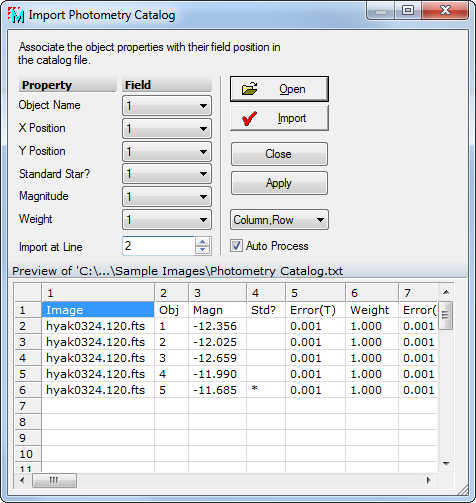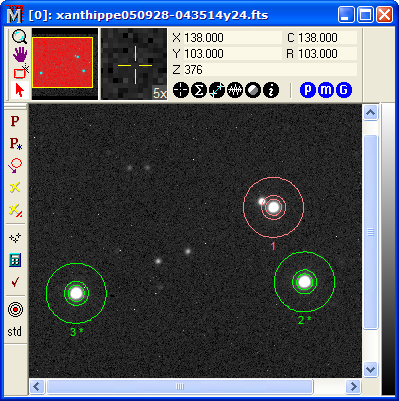
Import Photometry Catalog
The Import Photometry Catalog command opens a text format database to import coordinates and other information into Mira. The list of object coordinates may be generated using the Extract Sources command of the MExtract module, taken from a published catalog, or even saved from the photometry Report for stars marked in a previous photometry session.
This command is called from the Aperture Photometry Preferences dialog. Mira uses the imported data to define new object coordinates but not the aperture shape parameters. Optionally, Mira may also import whether the object is a standard and, if so, its standard magnitude and weight and an Object number.
Open this dialog by clicking the [Import Catalog] button on the Points page of the Aperture Photometry Preferences dialog.

The Import Photometry Catalog window is resizable. The example above shows the window scrolled to some of the more important columns that will be imported, namely, the magnitude, standard, and X,Y coordinates.
This tool is designed to preview and load databases containing information about objects to measure. The database must be in the format of a text file consisting of data in regular columns separated by tabs, one line per object. Not all columns must be used; you must tell Mira which columns contain the data of interest. As a minimum, the object positions must be imported as x,y (column, row) values or as (RA, Dec) values. The dialog has a list box from which you choose the format
Up to the first 50 columns and up to 50 lines of data will be inserted into the preview table, but the actual database file can have any number of columns and lines. The importing procedure is quite simple: associate the relevant column numbers with the appropriate quantity. For example, as shown above, the magnitude is listed in column 4 of the import database. Therefore, if you wish to import the magnitudes of standard stars from the database, you must tell select "4" in the "Magnitude" field. Mira can also skip some number of header lines. In the above example, it is set to begin importing at line 2 in order to skip the first line of column header labels you see in the file.
To import a catalog, Mira parses the lines of the file following a regular arrangement of data fields. Each data field, or column, must be separated by a tab character. In other words, if magnitude is to be imported and is found in column 4 on one line, then it must be in column 4 on every line of the database file. If the object on a given line does not have a magnitude, then the field would be blank but must still delineated by tabs.
|
Note |
This command can only import text files that use tabs to separate columns. |
Click [Open] to select the catalog file using the Open dialog. The contents of the file are listed in the Preview section of the Import dialog.
Determine which columns contain each Property and, for each property of interest, select the column number in its Field drop box.
Select the position format using the list box beneath the [Apply] button. Only (Column, row) and (RA, Dec) formats are available. This example uses the (column,row) coordinates. RA and Dec values may be interpreted in various formats such as 12h14m13.555s or 21.444532 or 19 12.5566. Each field may contain blanks, as in "19 12.5566" but cannot contain a tab.
Determine which line at which to begin loading data and enter that into the Import at Line field.
Check Auto Process to track and process the objects at these positions in all images. If this is not checked, the object list will be
To work with the previewed catalog and your settings, you may choose the following actions:
![]() To load the catalog,
click [Import].
To load the catalog,
click [Import].
![]() To simply save the
settings without importing, click [Apply].
To simply save the
settings without importing, click [Apply].
To leave the dialog, click [Close].
After import, the Image window looks like that shown below with new objects marked on the image. These objects were imported by (Column,Row) coordinates. If they would have been (RA,Dec) coordinates, Mira would have used the WCS calibration from the image header to compute the image (x,y) positions from the catalog (RA,Dec) positions.

In the above example, the Mark Centroid option was checked on the Points page so that the positions were centered on the stars near each imported coordinate. This option can be turned off to use the exact coordinates from the database.
If working with an Image Set and the images are reasonably well
aligned, you can paste the imported objects into the other images
by clicking ![]() on the toolbar. This button
tracks the centroid position of each object through the image set.
Alternatively, the Auto Process option
can automatically track the positions and perform the measurements.
To do this from the Import dialog, check Auto
Process and click [Import].
on the toolbar. This button
tracks the centroid position of each object through the image set.
Alternatively, the Auto Process option
can automatically track the positions and perform the measurements.
To do this from the Import dialog, check Auto
Process and click [Import].
If importing positions by (RA, Dec), the images must possess a WCS (World Coordinate System) calibration. Otherwise, Mira cannot determine the (column, row) position of the objects in the image. If the Track Centroid option is checked on the Points preferences page, the computed (column, row) position of each object will be refined by centroiding after applying its WCS transformation.
To copy the new object list to another Image Window, use the Copy Markers and Paste Markers commands.
Aperture Photometry, Aperture Photometry Preferences, Extract Sources command